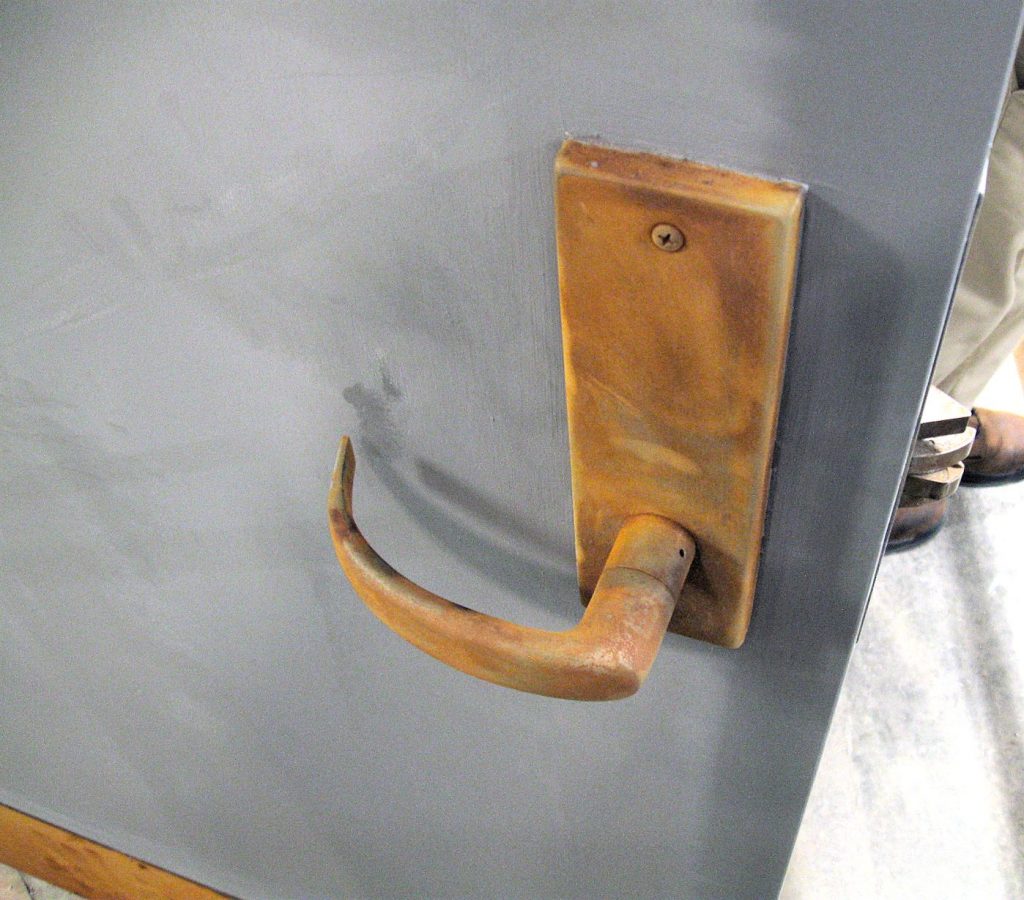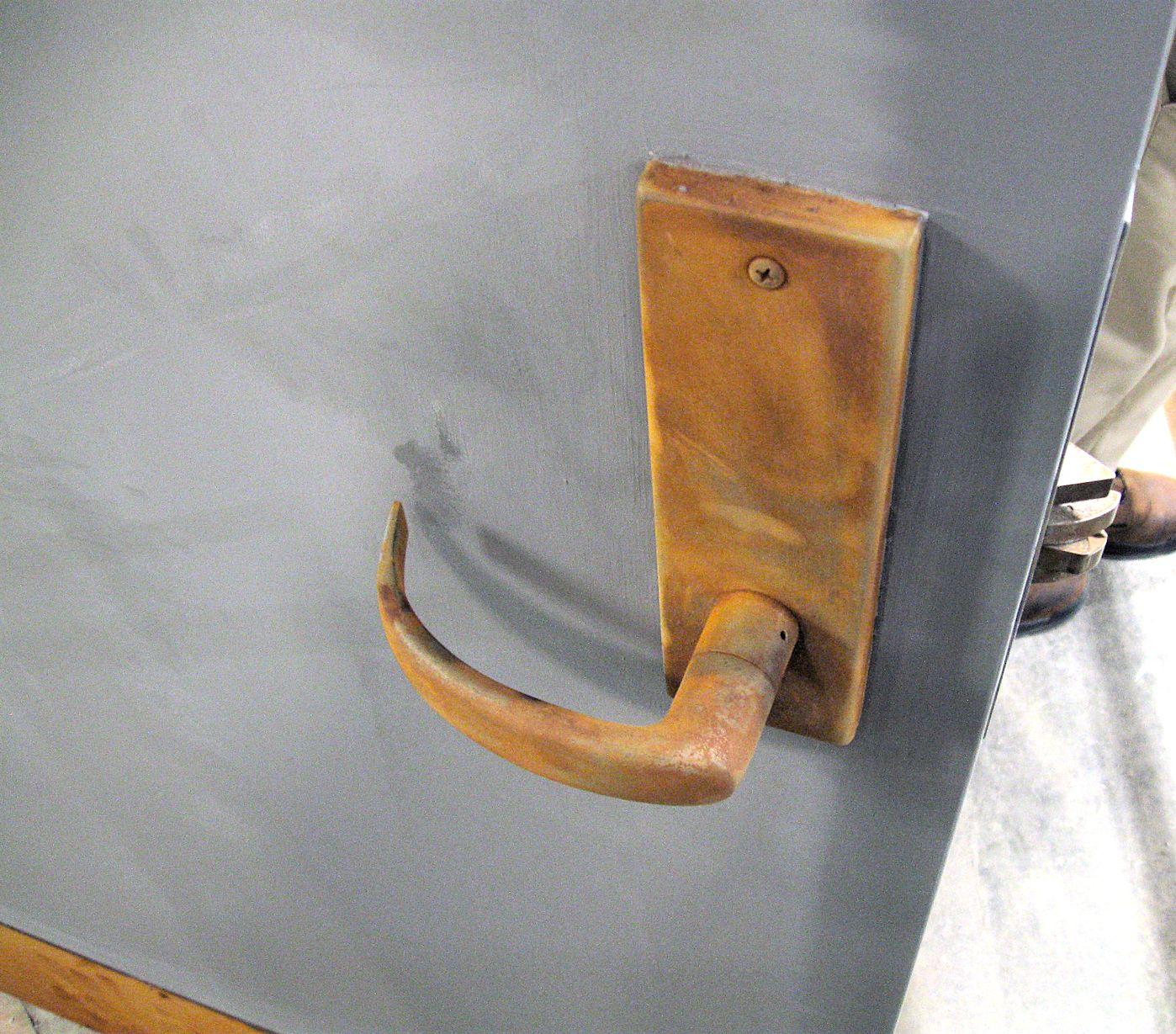 This lockset has been installed for a couple of months. The room is labeled “Acid” on the plans, and it is in a building that houses an indoor swimming pool. The finish was satin stainless steel – 630.
This lockset has been installed for a couple of months. The room is labeled “Acid” on the plans, and it is in a building that houses an indoor swimming pool. The finish was satin stainless steel – 630.
This product selection obviously isn’t working out very well, so here are a few questions…
- What types of rooms are “red flags” to help identify highly-corrosive environments?
- How do you solve these problems BEFORE hardware is installed?
- What product would you recommend to the facility manager to replace the existing lock?
-
WWYD?
Thanks to Scott Straton of Allegion for sending me this photo!
You need to login or register to bookmark/favorite this content.






A 630 Satin Stainless Finish is….just a finish. It is the base material that is the problem here. I would imagine that the internal works of the lock body are just as corroded. Stainless Steel base material for starters is what is needed to endure the corrosive environmental conditions.
Hi Michael –
The base material for 630 finish is stainless steel, but it didn’t withstand the chemicals stored in this room. I agree with you on the probably condition of the internal parts.
– Lori
Not sure what type of SS Schlage uses for there L9000 series locks, but Types 316 and 316L stainless steel are more resistant to general corrosion than the conventional Type 304.
I currently specify bright stainless finish with either a clear powder coat or anti-microbial powder coat in corrosive environments. One of the big three manufacturers used to use zinc as a base metal for their offshore mortise lock trim and I specified those for a swimming pool which was a huge mistake. The levers and escutcheons corroded instantly.
Maybe the room needs more ventilation. Falcon Mortise Series – you can specify corrosion resistant by using prefix X before the function. X581PD SS HG 630. The SS is Stainless Steel Mechanism.
That looks to uniform as SS does not really corrode. Are you sure this is 630 and not say a 626? I design water and wastewater plants and we specify 630 and rarely have a problem. Of course some contractors try to slip in a cheaper 626 and in a few weeks I get a call from the plant operator.
I assume this wasn’t your product Lori =)
Hi Lori –
Was this an Allegion product or a competitor? Did anyone ever find out if this was indeed 630 with SS base material? Did anyone ever determine what the base material was – 304, 316, etc? Interested to find out the recommended solution.
Hi Allen –
This doesn’t look like an Allegion product to me, but I don’t have any details on it. Stainless steel works well for some applications – a powder coat finish is another option.
– Lori
I’m surprised the hollow metal door is holding up as well as it is, considering what the environment has done to the trim. Looks like the door was repainted with the rusty trim still on it (I see masking lines on top edge), but don’t see any bubbling on the door surface.
True!
I’m not surprised it didn’t hold up very long. Years ago when I worked in commercial drywall and for a commercial GC I would have to go into newer hotels where the acoustic ceilings over the pools would literally have sections that fell down. Either standard or stainless steel ceiling wires had been used every time – neither of which would hold up to the corrosive environments of an enclosed pool area. There was a special bi-metal ceiling wire that I could only find at one distributor in the country that was made for corrosive environments as this, it was expensive, and I had to buy something like 1000 ft. spool at a time. Trust me, stainless steel will never work around indoor pool areas.
I’ll be curious how others here propose a solution for this door hardware. At least the kick plate still matches the leverset finish. (705 Non-Oil-Rubbed Rust?)
Unless I missed it, I don’t see anything in the Falcon MA Series catalog or price book offering the X prefix corrosion resistant function as suggested by Carol White in the above post. Note that the MA Series import replaces the M Series. The only truly corrosion resistant lockset that may be extant is the Falcon X Series Grade 1 cylindrical knobset. Note that it is necessary to add SS after the function code to specify an all stainless steel/non-ferrous mechanism. This feature has a $144.00 up-charge from list.
Check Falcon Price book.
I went back and researched what the ceiling wire material I used was that I used to use in enclosed pool areas – it called Monel Alloy 400 (UNSN04400). Monel 400 is a nickel/copper binary alloy of 63-70% nickel, with the balance copper. It is highly resistant to corrosion and acids.
If you want to read about it google “Monel Alloy 400 ceiling wire”.
So, based on the above, wouldn’t Nickel-Plated leversets be a good selection? Curious what others think?
Type 304 stainless does not hold up well in salt environments, which I believe is the same as chlorine. The same thing can happen at waterfront structures with salt spray. I think you have to dig fairly deeply to figure out if a particular hardware item is made with Type 304 or Type 316 stainless.
You HAVE to go with stainless when you are dealing with chlorine or salt exposure. The vapors that escape from the stored containers wreak havoc. Similar to why we use stainless hinges in operating rooms. Instead of vapors, they are constantly being sanitized by chlorine based cleaners. Regardless of the plating, the chemicals seep between the bearing surface of the hinge attacking the base metal. I definitely like the discussion about base metals better than conventional SS 304.
Several times i had to order 630 finish hardware for swimming pool. I never got this trouble on that. Probably a too much big concentrate of acid. I hope customers of this pool are still Alive !!!
Lockset with 630 finish, if some kind of special coating on lever or esc ( Similar like Hager is applying clear coating on Hinges will apply shall be applicable for such application.
How do you specify the Falcon X series as corrosion resistant?
Resolution:
Beginning in January 2015, to specify the X series as corrosion resistant, specify “SS” after the function. For example: X581 SS PD TG 630.
Prior to January 2015, corrosion resistant was specified as “XC” before the function. For example XC581 PD TG 630
Resolution: The “SS” option provides a stainless steel (non ferrous) constructed chassis that when paired with stainless steel trim, provides a Grade 1 lock that is resistant to corrosion when exposed to moisture and salt.
Maybe the owner should consider a less corrosive water treatment plan. 304 isn’t enough is some pool environments with poor ventilation and overuse of chlorine.
I agree with Farid. I had success in the past at pools and WWTPs with Sargent CPC (Clear Powder Coat)over 630.
A lot of information in a single blog, This is really nice to see. Thank you for sharing this. I think coating can also help in this, To prevent rust or corrosion. This is my thought but you have already shared all the necessary details regarding this. Thank you for sharing this.